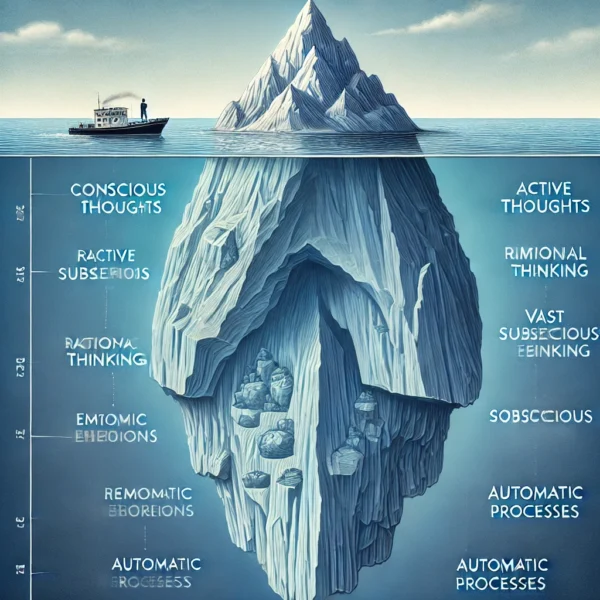The concept of the subconscious mind has fascinated psychologists, philosophers, and thinkers for centuries. This mind, often referred to as the unconscious, is a part of our mental framework that operates below the level of conscious awareness. It influences our thoughts, feelings, behaviors, and even our physical health in profound ways. This essay delves into the intricacies of the mind, its functions, and its impact on our lives.
Understanding the Subconscious Mind
The mind can be likened to an iceberg. The conscious mind, which includes our active thoughts, rational thinking, and immediate awareness, is merely the tip of the iceberg. Below the surface lies the vast expanse of the subconscious, which stores our memories, experiences, instincts, and much more. This part of the mind is not easily accessible to our conscious awareness, yet it profoundly influences our actions and reactions.
Functions of the Subconscious Mind
- Storage of Memories and Experiences: The Subconscious Mind is a vast repository of all our past experiences. It holds memories from early childhood that we might not consciously recall but that shape our behaviors and attitudes. These stored memories can influence how we respond to similar situations in the present.
- Automatic Processes: Many of our bodily functions, such as breathing, heartbeat, and digestion, are controlled by the mind. It also governs automatic behaviors and habits. For instance, once we learn to ride a bicycle or drive a car, the mind takes over, allowing us to perform these tasks without conscious thought.
- Emotional Responses: The Subconscious Mind plays a crucial role in our emotional responses. It is where our instincts and primary emotions reside. Often, we react to situations based on ingrained patterns of behavior stored in the subconscious, rather than through deliberate, conscious thought.
- Beliefs and Attitudes: Our core beliefs and attitudes, which shape our worldview and influence our decisions, are rooted in the subconscious. These beliefs are often formed in childhood and can be difficult to change without conscious effort and reprogramming.
The Power of the Subconscious Mind
The power of the Subconscious mind lies in its ability to influence our conscious thoughts and behaviors. Here are some ways in which the mind manifests its power:
- Influence on Decision Making: While we like to believe that our decisions are made rationally and consciously, the Subconscious Mind plays a significant role in the decision-making process. It processes information at a much faster rate than the conscious mind and often guides us toward decisions based on past experiences and ingrained beliefs.
- Creativity and Problem-Solving: Many great ideas and solutions to problems arise when we are not actively thinking about them. This is because the mind continues to work on problems in the background, even when we are not consciously focused on them. This is why people often experience sudden insights or “aha” moments.
- Behavioral Patterns: Our habits and behaviors are largely dictated by the mind. This is evident in the way we perform daily routines and respond to familiar situations. Changing these patterns requires conscious effort and persistence because they are deeply embedded in the subconscious.
- Physical Health: The mind-body connection is well-documented, and the mind plays a crucial role in this relationship. Stress, for instance, is processed in the subconscious and can manifest in physical symptoms such as headaches, high blood pressure, and weakened immune function. Conversely, positive thinking and visualization techniques can promote healing and overall well-being.
Techniques for Accessing and Reprogramming the Mind
Given the significant influence of the mind on our lives, many people seek ways to access and reprogram it to achieve personal growth and improvement. Here are some techniques that can be effective:
- Hypnosis: Hypnosis is a state of deep relaxation and focused attention that allows access to the mind. Under hypnosis, individuals can explore repressed memories, alter negative thought patterns, and implant positive suggestions. This technique is often used in therapeutic settings to address issues such as phobias, addictions, and trauma.
- Meditation: Meditation involves quieting the conscious mind and achieving a state of deep relaxation and heightened awareness. Regular meditation practice can help individuals become more attuned to their subconscious thoughts and feelings, leading to greater self-awareness and personal insight.
- Affirmations: Affirmations are positive statements that are repeated regularly to reinforce desired beliefs and behaviors. By consistently repeating affirmations, individuals can reprogram their Subconscious Mind to adopt new, positive thought patterns. This technique is widely used for personal development and goal achievement.
- Visualization: Visualization involves creating vivid mental images of desired outcomes. By imagining success and positive scenarios, individuals can influence their mind to work towards these goals. Visualization is often used by athletes, performers, and successful individuals to enhance performance and achieve their objectives.
- Journaling: Writing down thoughts, feelings, and experiences can help individuals access their mind. Journaling provides a means to explore and understand underlying emotions and beliefs, facilitating personal growth and transformation.
- Mindfulness: Mindfulness involves paying attention to the present moment without judgment. By practicing mindfulness, individuals can become more aware of their automatic thoughts and reactions, allowing them to address and change negative patterns rooted in the subconscious.
This Subconscious Mind in Therapy
The role of the mind is particularly prominent in therapeutic settings. Various therapeutic approaches focus on accessing and understanding the subconscious to address psychological issues and promote healing.
- Psychoanalysis: Developed by Sigmund Freud, psychoanalysis aims to uncover repressed memories and unresolved conflicts stored in the subconscious. Through techniques such as free association, dream analysis, and transference, therapists help individuals bring subconscious material to conscious awareness for resolution.
- Cognitive Behavioral Therapy (CBT): While CBT primarily focuses on changing conscious thoughts and behaviors, it also acknowledges the role of the subconscious in shaping these patterns. By identifying and challenging automatic negative thoughts, individuals can reprogram their Subconscious Mind to adopt healthier ways of thinking.
- EMDR (Eye Movement Desensitization and Reprocessing): EMDR is a therapeutic approach used to treat trauma and PTSD. It involves stimulating the brain through bilateral eye movements while recalling traumatic memories. This process helps reprocess and integrate traumatic experiences stored in the subconscious, reducing their emotional impact.
- Inner Child Work: Inner child work involves connecting with and healing the wounded aspects of one’s subconscious, often stemming from childhood experiences. This therapeutic approach helps individuals address unresolved emotions and traumas, leading to greater self-acceptance and emotional well-being.
Personal Growth
Understanding and harnessing the power of the mind can lead to significant personal growth and self-improvement. By accessing and reprogramming the subconscious, individuals can overcome limiting beliefs, develop healthier habits, and achieve their goals.
- Overcoming Limiting Beliefs: Many of our self-imposed limitations are rooted in the mind. By identifying and challenging these beliefs, individuals can break free from self-sabotaging patterns and unlock their full potential.
- Developing Positive Habits: Changing habits requires more than just conscious effort. By reprogramming the mind through techniques such as affirmations and visualization, individuals can develop and maintain positive habits that support their well-being and success.
- Achieving Goals: The mind plays a crucial role in goal achievement. By aligning the conscious and mind through visualization and positive reinforcement, individuals can stay focused and motivated to achieve their objectives.
- Enhancing Self-Awareness: Greater self-awareness leads to better understanding and management of one’s thoughts, emotions, and behaviors. By exploring the mind, individuals can gain insights into their true desires, motivations, and strengths.
- Improving Relationships: Our interactions with others are influenced by subconscious patterns and beliefs. By addressing and healing these patterns, individuals can develop healthier, more fulfilling relationships.
Mind holds
The mind holds incredible power, shaping our perceptions and actions. It stores memories, processes emotions, and fuels creativity. Our thoughts can uplift or hinder us, demonstrating the profound influence of mental states. By nurturing positive thinking and mindfulness, we unlock the potential for growth, resilience, and inner peace, harnessing the mind’s capabilities for a fulfilling life.
Unconscious mind
The unconscious mind is a vast and mysterious part of our mental landscape, influencing thoughts, feelings, and behaviors without our awareness. It stores memories, instincts, and desires, shaping our reactions and decisions in subtle yet profound ways. This hidden realm operates beneath the surface, guiding habits and automatic responses. Freud likened it to an iceberg, with the conscious mind merely the tip visible above water. Understanding the unconscious mind can unlock deeper self-awareness, revealing the roots of fears, motivations, and patterns. By exploring this hidden territory, we can foster personal growth, emotional healing, and a richer understanding of human nature.
Conclusion
The Subconscious Mind is a powerful and mysterious aspect of our mental landscape. It influences our thoughts, behaviors, and physical health in profound ways. By understanding and accessing the subconscious, individuals can harness its power to achieve personal growth, overcome limitations, and lead more fulfilling lives. Techniques such as hypnosis, meditation, affirmations, visualization, and therapeutic approaches offer pathways to reprogram the mind and unlock its potential. Embracing the power of the mind can lead to a deeper understanding of oneself and a more empowered approach to life.






